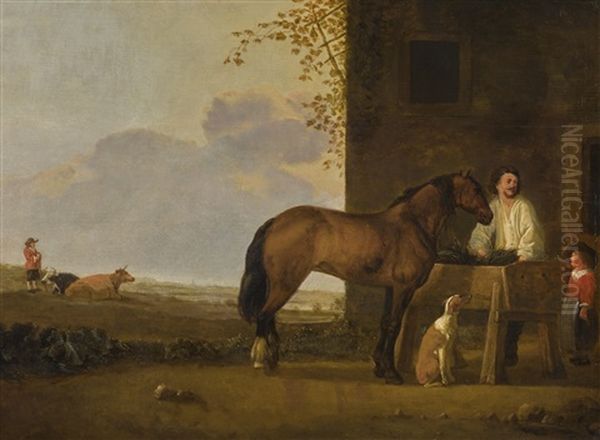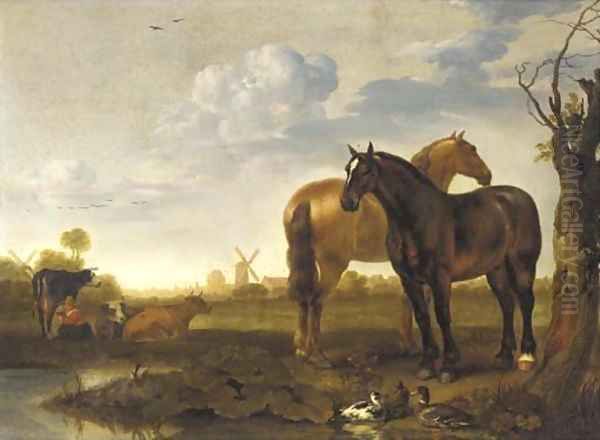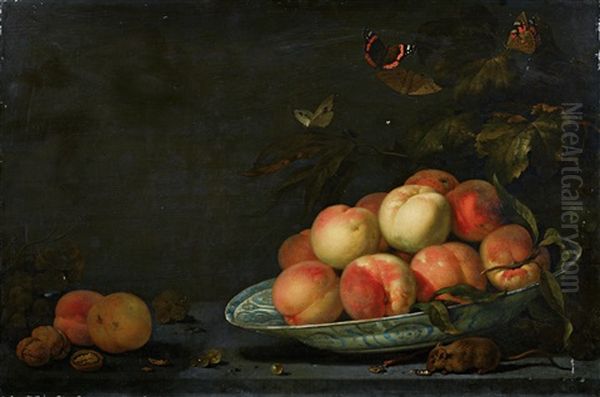
Abraham van Calraet stands as a notable figure within the rich tapestry of the Dutch Golden Age of painting. Active primarily in the city of Dordrecht, his life spanned a period of immense artistic flourishing in the Netherlands, from his birth in 1642 to his death in 1722. While perhaps less universally recognized than some of his contemporaries, Van Calraet carved a distinct niche for himself, excelling in the genres of still life, landscape, and animal painting. His career, however, is intrinsically linked, and sometimes overshadowed, by his close association with the celebrated Dordrecht master, Aelbert Cuyp, leading to fascinating questions of influence, imitation, and attribution that continue to engage art historians.
Understanding Van Calraet requires delving into his specific context within the Dordrecht School, appreciating his technical skill, particularly in rendering textures and light, and acknowledging the complexities surrounding his artistic identity. His works, found today in prestigious collections worldwide, offer a window into the artistic preoccupations of his time, showcasing both intimate observations of nature and idyllic visions of the Dutch countryside.
Early Life and Artistic Formation in Dordrecht
Abraham van Calraet was born in Dordrecht in October 1642, baptized on the 12th of that month. His roots were firmly planted in the artistic milieu of the city. He was the eldest son of Pieter Jansz van Calraet, a respected sculptor. This familial connection to the arts likely provided Abraham with his initial exposure to creative practice. It is understood that he first learned the craft of sculpture under his father's guidance, mastering the handling of form in three dimensions before transitioning to the two-dimensional medium of painting.
His younger brother, Barent van Calraet (1649–1737), also pursued an artistic career, initially focusing on painting horses before later turning to landscapes, notably imitating the style of the Rotterdam painter Herman Saftleven II, known for his Rhineland views. This suggests an environment where artistic pursuits were encouraged within the family. While Abraham's initial training was in sculpture, his eventual path led him firmly into the world of painting, where he would make his most significant contributions.

Sources, including the influential artist biographer Arnold Houbraken writing in the early 18th century, suggest that Abraham may have received further instruction from local Dordrecht sculptors, potentially Aemilius Huppe and Samuel Huppe. While definitive documentation of his formal painting apprenticeship is scarce, his stylistic development clearly indicates absorption of the prevailing trends and techniques within the active Dordrecht artistic community. His transition from sculpture to painting marked the beginning of a career dedicated to capturing the nuances of light, texture, and atmosphere on canvas.
The Artistic Environment of Dordrecht
Dordrecht, during the 17th century, was a thriving center for trade and culture, fostering a distinctive school of painting. Situated strategically on the confluence of rivers, the city's environment, characterized by water, meadows, and a unique quality of light, profoundly influenced its artists. The Dordrecht School is particularly renowned for its landscape painters, who captured the serene beauty and atmospheric effects of the local countryside, often imbued with a warm, golden light that became a hallmark of the style.
Key figures dominated the Dordrecht scene. Jacob Gerritsz. Cuyp (1594–1651/52), father of the more famous Aelbert, was a prominent portraitist and also painted landscapes and biblical scenes, laying some groundwork for the local landscape tradition. His son, Aelbert Cuyp (1620–1691), became the city's most celebrated painter, mastering the depiction of Dutch landscapes bathed in an idealized, often Italianate, golden light, frequently populated with cattle and figures. His influence was pervasive, casting a long shadow over subsequent generations of Dordrecht artists.
Other notable artists active in or associated with Dordrecht during this period included Samuel van Hoogstraten (1627–1678), known for his perspective boxes, portraits, and genre scenes, and who also wrote on art theory. The presence of such accomplished artists created a stimulating environment for younger painters like Abraham van Calraet. He absorbed the local traditions, particularly the emphasis on landscape and the sensitive rendering of light and atmosphere, while also responding to the dominant influence of Aelbert Cuyp.
The Pervasive Influence of Aelbert Cuyp
The connection between Abraham van Calraet and Aelbert Cuyp is central to understanding Van Calraet's artistic trajectory. Art historical consensus, supported by sources like Houbraken, identifies Van Calraet as a significant pupil or, at the very least, a close follower and imitator of Aelbert Cuyp. Cuyp's style, itself a unique synthesis, combined elements of Dutch realism with an idealized, atmospheric luminosity often associated with Italian landscape painting, possibly absorbed through the works of Utrecht Caravaggisti or artists like Jan Both who had travelled to Italy.

Van Calraet clearly studied Cuyp's work intently. His landscapes often echo Cuyp's preferred subjects: tranquil river views, pastoral scenes with cattle basking in sunlight, stable interiors, and depictions of horses. More importantly, Van Calraet adopted key elements of Cuyp's technique. This included the use of warm, golden light to create a serene and idyllic mood, a relatively smooth application of paint in certain areas, and specific ways of rendering foliage and animal hides. The influence extended to compositional structures as well.
Aelbert Cuyp himself drew inspiration from earlier Dutch landscape traditions, notably the tonal phase associated with painters like Jan van Goyen (1596–1656), characterized by near-monochromatic palettes and emphasis on atmosphere. Van Calraet, in emulating Cuyp, indirectly inherited aspects of this broader landscape tradition, blending Cuyp's luminous colour with careful observation. This close stylistic affinity demonstrates Van Calraet's admiration for the older master and his successful assimilation of the dominant local style.
The Conundrum of Attribution: The "A.C." Signature
One of the most significant challenges in studying Abraham van Calraet arises from his signature. He typically signed his works with the monogram "A.C." Unfortunately, these are the exact same initials used by the far more famous Aelbert Cuyp. This coincidence of initials, combined with the undeniable stylistic similarities between the two artists, created considerable confusion in the art market and among collectors and historians for centuries.
For a long period, particularly during the 18th and 19th centuries when Cuyp's reputation soared, works genuinely painted by Van Calraet were frequently misattributed to Aelbert Cuyp. The allure of the bigger name often meant that dealers and collectors preferred a Cuyp attribution, inadvertently obscuring Van Calraet's own achievements. Consequently, Van Calraet's oeuvre was underestimated, and his distinct artistic personality was difficult to discern beneath the shadow of his presumed master.
It was not until the late 19th and early 20th centuries that art historians began to systematically re-examine works signed "A.C." Scholars started to identify subtle but consistent differences in handling, composition, and subject matter that allowed them to distinguish between the two artists. For instance, some scholars noted differences in the way horses were depicted or variations in the treatment of foliage. This painstaking process of connoisseurship gradually led to the reattribution of numerous paintings, restoring a significant body of work to Abraham van Calraet. This ongoing scholarly work has allowed for a fairer assessment of his talents and contributions, though the shared initials ensure that attribution questions occasionally still arise.
Mastery in Still Life Painting

While often discussed in relation to Cuyp's landscapes, Abraham van Calraet also excelled in the genre of still life, particularly fruit pieces. His still lifes are characterized by careful composition, a sensitivity to texture, and a nuanced depiction of light interacting with surfaces. He often arranged fruits like peaches, grapes, apples, cherries, and melons on simple stone ledges or tables, sometimes accompanied by foliage, insects, or reflective vessels.
His skill in rendering the specific textures of fruit was highly regarded. Samuel van Hoogstraten, in his 1678 treatise "Inleyding tot de hooge schoole der schilderkonst" (Introduction to the Academy of Painting), praised Van Calraet's ability to depict "a whole sideboard full of beautiful peaches." This contemporary recognition highlights his reputation in this genre. Peaches, with their fuzzy skin and delicate coloration, appear frequently in his work and seem to have been a particular specialty.
A prime example is his Still Life with Peaches, Grapes, Melon and a Butterfly on a Stone Plate (c. 1660-1680), now in the Leiden Collection. This work showcases his ability to capture the bloom on the grapes, the downy texture of the peaches, and the segmented surface of the melon, all bathed in a soft, focused light. Interestingly, this painting was once attributed to another Dordrecht artist, Godefridus Schalcken (1643–1706), a pupil of both Van Hoogstraten and Gerard Dou. However, stylistic analysis, particularly the handling of light and the specific manner of signing (though unsigned, related signed works confirm the style), led to its firm attribution to Van Calraet. This demonstrates the quality Van Calraet achieved, comparable to other respected specialists. Another known work, Still Life of Apples and Cherries, is housed in the prestigious Mauritshuis in The Hague.
Landscapes and Animal Painting
Beyond still life, Abraham van Calraet made significant contributions to landscape and animal painting, genres where the comparison with Aelbert Cuyp is most apparent. He painted tranquil scenes of the Dutch countryside, often featuring rivers, meadows, and distant town views, capturing the specific atmospheric conditions of the region around Dordrecht. His landscapes frequently include animals, particularly horses and cattle, which he depicted with anatomical accuracy and sensitivity.
Works like Scene on the Ice outside Dordrecht (National Gallery, London) show his ability to handle genre elements within a landscape setting, capturing the activities and atmosphere of a Dutch winter. View of a River Town (National Museum of Sweden, Stockholm) exemplifies his skill in rendering calm waters reflecting the sky, a common motif in Dutch landscape painting. These works often possess the warm, hazy light associated with Cuyp, creating an idyllic and peaceful mood.
His depictions of horses were particularly accomplished. Interior of a stable with two dapple-greys (National Gallery of Art, Washington) demonstrates his understanding of equine anatomy and his ability to render the texture of their coats and the play of light within a dimly lit interior. A horseman tending his horse (Mauritshuis, The Hague) and Two horses and a milkmaid with cows in a landscape... (Mauritshuis, The Hague) place the animals within broader pastoral settings, integrating them seamlessly into the landscape. Other examples include Horses Tied to a Tree and Halt at an Inn (both National Museum of Sweden, Stockholm), and Horsemen in a Ravine (National Gallery of Art, Washington). While clearly influenced by Cuyp, Van Calraet's animal paintings often have a quiet intimacy and focus that can be seen as characteristic of his own approach.
Other Contemporaries and Artistic Connections
While the relationship with Aelbert Cuyp dominates discussions of Van Calraet, he existed within a broader network of artists. His brother, Barent van Calraet, provides a direct family link within the Dordrecht art scene. As mentioned, Barent shifted his style to emulate Herman Saftleven II, indicating the diverse influences available to Dordrecht artists beyond the immediate circle of Cuyp.
The temporary misattribution of his peach still life to Godefridus Schalcken highlights stylistic parallels, even if direct collaboration or interaction isn't documented. Schalcken, known for his candlelit scenes and fine finish, represents another facet of Dordrecht's artistic output. Samuel van Hoogstraten's mention of Van Calraet in his treatise places him within the discourse of contemporary art theory and criticism, acknowledging his skill among his peers.
Arnold Houbraken, whose "De groote schouburgh der Nederlantsche konstschilders en schilderessen" (The Great Theatre of Dutch Painters and Paintresses) is a key source for the period, provides biographical details and confirms the pupil-teacher relationship with Cuyp, as well as mentioning Abraham's father, Pieter Jansz, and brother Barent. Although the provided snippets mention Pieter Jansz's association with artists like Pieter Claesz (a Haarlem still life painter) and Pieter Codde (an Amsterdam painter of portraits and genre scenes), there's no direct evidence linking Abraham van Calraet to these specific artists outside his father's sphere. His primary artistic dialogue seems to have been with the legacy of Cuyp and the traditions of the Dordrecht School.
Collections and Enduring Legacy
Despite the historical confusion surrounding his name and signature, Abraham van Calraet's works have found their place in numerous important public and private collections across the globe. This distribution testifies to the enduring appeal and quality of his paintings. His works are represented in major European museums, including the National Gallery in London, the Mauritshuis in The Hague, the Rijksmuseum in Amsterdam, the National Museum of Sweden in Stockholm, and museums in Antwerp.
In the United States, his paintings can be found in the National Gallery of Art in Washington D.C. The Leiden Collection, a significant private collection specializing in 17th-century Dutch art, also holds key works, including the aforementioned peach still life. The presence of his art in these institutions allows for continued study and appreciation by scholars and the public alike.
Abraham van Calraet's legacy is that of a highly skilled painter from the Dordrecht School who mastered several genres. While inevitably linked to Aelbert Cuyp, modern art history recognizes him as an artist with his own merits. His still lifes are admired for their sensitivity and technical finesse, particularly the depictions of fruit. His landscapes and animal paintings capture the serene beauty of the Dutch countryside with a warmth and intimacy that, while echoing Cuyp, possess their own distinct charm. He remains an important figure for understanding the depth and diversity of artistic production in Dordrecht during the Dutch Golden Age.
Conclusion: A Rediscovered Dordrecht Talent
Abraham van Calraet navigated the vibrant art world of 17th-century Dordrecht, developing considerable skill in still life, landscape, and animal painting. Born into an artistic family and initially trained as a sculptor, he transitioned successfully to painting, becoming closely associated with the city's preeminent master, Aelbert Cuyp. This association proved both beneficial and challenging; while he absorbed much from Cuyp's influential style, particularly the handling of light and atmosphere, the shared "A.C." initials led to centuries of misattribution that obscured his individual contributions.
Thanks to dedicated art historical research, Van Calraet's oeuvre has been more clearly defined, revealing a painter of significant talent. His fruit still lifes, praised even in his own time, showcase meticulous observation and a delicate touch. His landscapes and animal scenes, though indebted to Cuyp, offer charming and tranquil visions of the Dutch environment. Today, his works are appreciated in major museums worldwide, securing his position as a distinct and valuable voice within the celebrated Dordrecht School and the broader context of the Dutch Golden Age. He stands as a testament to the depth of talent that flourished in the Netherlands during this remarkable period.